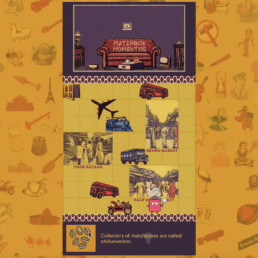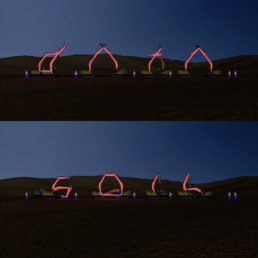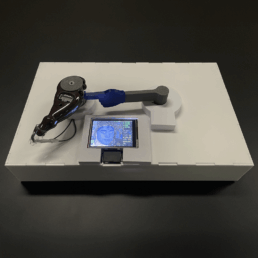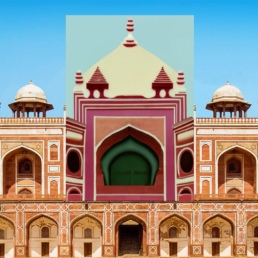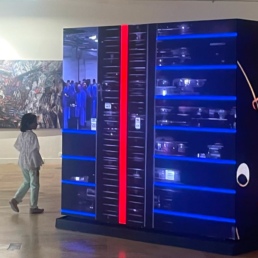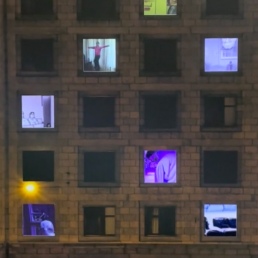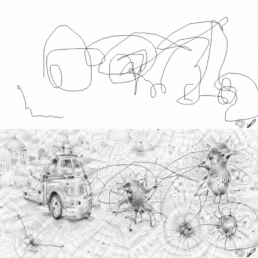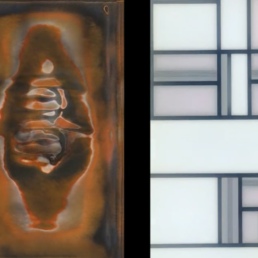Matchbox Momentos
Matchbox Momentos
Medium- Web based experience, part of Google Arts and Culture's phone and web app
Created by artist Harshit Agrawal in collaboration with Google Arts & Culture (GAC) and his collaborators Imaginative Identity Creators, GAC partners Museum of Art & Photography and Tasveer Ghar.
Play Matchbox Momentos
How can emerging technologies help showcase the unique beauty, stories, visual language and history of Indian cultural artifacts?
This was the starting point for Mumbai-based artist, Harshit Agrawal, during his residency with Google Arts & Culture Lab.
Harshit created this playful interactive experiment to celebrate Indian nostalgia and Gautam Hemmady’s matchbox art collection – the largest collection in India.
This residency was in collaboration with Museum of Art & Photography, who Gautam donated his collection to and Tasveer Ghar, the South Asian archivists, who provided the digital archive of Gautam’s collection for the purpose of this experiment.
About the Experiment
Discover and collect up to 342 rare snapshots of India’s cultural history across 19 themed journeys. Each board has 19 matchbox artworks to collect. Including a special edition collectible matchbox artwork. The special edition collectible is created by the artist Harshit Agrawal, inspired by Gautam Hemmady’s original matchboxes and generated with the help of Google AI.
Harshit invites you to celebrate his Indian cultural heritage and step into the footsteps of late collector Gautam Hemmady. Journey India’s famous bazaars to build your own matchbox art collection in an interactive story inspired by Moksha Patam – now known as Snakes & Ladders. A game originated in India where the board represents life’s journey.
About Indian Matchbox Artworks
Matchbox artworks have a rich and vibrant history in India, capturing changes and stories of Indian society. Indian collectors preserved this unique heritage as a hobby finding thrill and intrigue in hunting for these rare items.
The matchboxes come from the largest collection of matchboxes in India – donated to Museum of Art & Photography and Tasveer Ghar by the late Gautam Hemmady.
Discover more about Gautam’s journey as a collector and dive into the storytelling of a nation on Google Arts & Culture.
Thanks to our partners Museum of Art & Photography and Tasveer Ghar for use of their physical collection and digital archive; and Harshit’s collaborators Imaginative Identity Creators Pvt. Ltd.
Data Excavations- the New (S)oil
Data Excavations- the New (S)oil
Conceptualized and created in the Mazrah Art Residency at Diriyah Art Futures.
Medium (for life size installation)- 60 x 15 x 8 meter, 9 Industrial Excavator Machines, Pink LED strips, Control Circuitry. Year 2025.
Medium (for indoor tabletop installation)- 5 x 2.5 x 3.5 feet, 9 toy scaled down excavator machines, Pink LED strips, Control Circuitry. Year 2025
A Kinetic Light Art Installation. This artwork focuses on drawing parallels of excavations of Earth’s resources by heavy machinery and the large scale excavations of human data today. Often intangible, data excavations have the potential to go unnoticed. We don’t realize the extractive nature of AI and data. On the flip side of this extraction is the other scope determined by intentionality, it’s the possibility of progress that machines like excavators have brought about- data allows us to build on insights and create pillars of progress too. The work brings forth this parallel through a kinetic light installation where the artist plans installs glowing light channels to the arms of industrial excavators and choreographs a movement of the machinery to write the words ‘data’ and ‘soil’ in a continuous loop.
The work is created to be both a large scale installation in an open land space with life size excavator machines, with the choreography of writing performed by trained operators and an indoor installation on a table-top with scaled down toy excavator machines with a custom electronic circuitry to perform the writing movements autonomously in a loop.
Machinic Meditations
Machinic Meditations
Conceptualized and created in the Mazrah Art Residency at Diriyah Art Futures.
Medium: Digital Bead Clicker, Motor circuitry, 3D Printed parts, Fabricated casing with PLA and wood. Year 2025
A Kinetic Art Installation. This artwork transforms the found object of digital counter beads, commonly found in the region into a kinetic art installation- where a mechanized motor based arm continuously rotates the bead instead of a human hand. The artist creates a diptych work- with 2 such units of mechanized system. These are conceptualized to represent AI server racks in an AI data center. The diptych represents one server rack ‘meditating’ on human data and another ‘meditating’ on resources of energy and water to carry out the computations and functioning of the data center.
In the former server rack, with each bead rotation- the system reads a new point in a human dataset. The counter resets after 32 counts, and picks on a new batch of human data points to process or meditate through. In the latter the machine reads into new resource availabilities of energy and water to keep functioning- a data center uses upto 2 million litres of clean drinking water daily and 250,000 kWH per day.
The work looks to bring up questions around the evolving nature of ritualistic practices in a time of Artificial Intelligence. When machines clear level 1 of knowing everything, what are ways in which they evolve to go beyond and build cultural and ritualistic practices of their own? Count keeping which is central to cultural practices across humanity, is central and fundamental to computer systems too- a clockwork precision of meditations on human data and climate resources (the entities that create them and make them function).
The work pokes at the question of ‘automating’ human labor broadly too- we began by outsourcing most of our mundane tasks to machines, and today we already speak of ‘automating’ creative labor. Does this indicate a shift to automating spiritual labor too? We continue evolving new practices for the AI world, like scrolling through our phones whilst potentially transferring the labor of existing practices like scrolling through beads to machines?
Ritual Robots- Havan at the Data Kund
Ritual Robots - Havan at the Data Kund
Medium- Modified Metal Hawan Kund, Robotic Arm, Offering Bowls, LED strips, Micro-controllers. Dimension- 36 inch x 30 inch. Year- 2025
Data centers, which run all the AI of today globally consume about 143 million books’ worth of data everyday. Every second, they need water which is enough to provide daily water for about 2 million people. AI is the central reality of our times. It’s a reality centered on massive amounts of human data scraping (often without awareness of humans) and massive amounts of extraction of Earth’s resources. AI machines collect every aspect of our lives in data and are able to manipulate that to influence our lives in all kinds of ways- from potentially naive aspects like what shoes to buy to influencing elections at scale. We are caught within filter bubbles and have no awareness of the ideological walls we are trapped within. We, as human consumers share all this data willingly- almost like offerings, very much like making offerings in ritualistic practices. This data requires processing with huge amounts of compute powered by indiscriminate extraction of resources- with data centers set to account for 21% of the global energy needs within 5 years. The offering we are making, in massive amounts to the robots is that of data and the climate. This work highlights that process, hinting at the evolution of the superior being to AI robots and our evolution of rituals along the same lines.
The Past (is) Tense HT
The Past (is) Tense HT
Medium- Custom AI trained model video on digital photograph. MP4 file. Year- 2022. Dimensions Variable.
In this work, the artist uses AI to speculate layered pasts rooted in the socio-political context of the present. The artist works with architectural structures symbolic of the diverse cultural influences of India’s past. Cut out parts of these are juxtaposed with AI imagined erasures of this diverse richness to hint at the present’s tense narratives around these themes. The past is always moulded in the politics of the present. Could technologies of today then, the same ones used for percolating these narratives, be used for perceiving these pasts in alternate ways? Is this an act of encroachment, hybridization, erasure or simply forced speculation?
The G(u)arden of Digital Delights
The G(u)arden of Digital Delights
Medium- 7.5 x 7.5 x 6.6 ft LED cuboid. 4 part AI video with audio. Year 2023.
Through this work, the artist builds on Hieronymus Bosch’s famed work ‘The Garden of Earthly Delights’ to question the idea of delight in today’s times, and the metaphor of garden as a place for relaxation and enjoyment, simultaneously a place for establishing and maintaining a sense of identity. The artist draws this parallel to digital gardens of today- data centers and digital filter bubbles, created with the g(u)ardening tools of AI like drones, surveillance, data, algorithms. The role of the gardener draws parallel to the role of the the human labor in AI. Often wrongly perceived as a self-functioning independent entity, AI builds on the labor of millions of invisible people sitting hours in front of screens tagging data, looking at extremely disturbing content for moderation, all to maintain a sense of digital delight and properness. The digital delight is crafted and curated to keep people in the confines of bubbles, enforcing an identity trapped in this guarded garden.
The artwork is a 3 minute 41 second quadriptych (4 part) video work with custom made audio, artwork made in 2023. The artwork will be displayed in 4 square digital displays or 2 horizontal digital displays, preferably at a right angle wall, with 2 parts of the video playing on each wall. Each part of the video talks about different notions of the digital garden today, with one part speaking about the labor involved in creating and maintaining such a digital garden.
Inside Out
Inside Out
Medium: 14 Digital Screens, AI generated Video loops, Wood, Archival Print on Paper. Year- 2022. Dimensions- 66 x 30 inch x 2 inch
The last 2 years have radically changed how we live and engage with the world. Stuck indoors, people have found new ways to feel a sense of belonging and liveliness. It has accelerated our journey to becoming increasingly digitally native, existing more in bits and bytes than atoms and molecules. In this work, the artist creates an apartment facade, though replacing windows with screens, which act both as a means to communicate our digital identity and engagement with the world, an entry into embracing the metaverse, and to capture each of our own solicitation in the digital for companionship. The screens show performative works generated with AI, where the artist ‘learns’ by downloading via an AI new hobbies like dancing, yoga while being stuck inside digital windows (onto his avatar).
Tandem
Tandem
Medium- Custom Interactive Software, Custom AI Model, Digital Drawing Screen, Computer. Year- 2015. Dimensions Variable
Through this interactive work, my earliest artwork with AI (made in 2015)- i began pondering the question of coming together of human and machine creative expression. Tandem is an interactive drawing tool, with an interface like any simple drawing application, however it’s one with an AI capable of ‘imagination’- which can turn your doodles into something unexpected and invite you to have a visual creative dialogue with itself. The audience begins the interaction by doodling or drawing something. The audience can then select a ‘personality’ type for the AI between options of ‘Happy, Dreamy, Dark, Angry’ and a non-personality option of ‘Pencil’. These give different visual stylistic outputs. The other choice to make is between ‘Abstract’ or ‘Figurative’ outputs- this results in the AI output to vary from abstract pattern outputs to more figurative identifiable elements based on the categories of AI’s training. The system works using the Deepdream AI technique primarily, which relies on AI’s training on the Imagenet dataset comprising ~14 million images in 1000 categories. The distinction between Abstract and Figurative happens by determining the layer the Deepdream algorithm uses to be the final layer in each step of its creation. Abstract patterns are achieved by chosing earlier layers in the Deepdream algorithm and figurative ones achieved by letting the Deepdream algorithm run till the final layers. The ‘personality’ is applied with the Neural Style Transfer Algorithm run on the Deepdream output using pre-curated images for each category of the personality. For the pencil stylistic category- i use a custom written Open CV script to transform the Deepdream output to a pencil sketch style artwork. The Deepdream algorithm comprising of Convolutional Neural Networks was a major breakthrough in deep learning, exhibiting the machine’s capability to ‘imagine’ visual material. Through Tandem, the input for machine imagination is human doodles and Tandem explores this interaction from the capacity of forming a human-machine creativity continuum.
When the human starts to doodle something, the AI ‘recognizes’ it as objects it knows and the biases inherent in it. It then imagines on top of the human drawing with each iteration of its creation. The human could choose to continue this cycle of imaginations by editing the machine’s output or re-feeding it its own output. Someone interacting with this work experiences the eerie continuities and discontinuities between the human and machine imagination where our own human visual categories (which the machine has been trained on) are filtered and estranged through the (sometimes alien) associations the machine makes. Mindless doodles often turn into definitive objects which we might not have imagined ourselves, however once we start to see those emerge from the machine’s imagination- we start to associate with those objects in the context of our drawings too. It becomes a playful mechanism to peep into the inner functioning of the AI’s algorithm or ‘imagination’ too. This was a critical part of the thinking behind the work, especially given how new the idea of AI generating completely new visuals was back when Deepdream released- making an interactive system to explore its workings would invite people to form their own insights and relations with the machine rather than being prescribed one. Such active engagement with AI systems is crucial for taking ownership of the narrative and influence of these technologies, in debunking their hype and confusions- instead creating more tangible ways to critique it.
The output raises some pertinent points to ponder. We are left to wonder whose was that final drawing? The human interlocutor’s? The AI’s? Or does it really belong to the deep formal patterns in the human subconscious that the machine learns through looking at the way we form associations between the verbal and the visual?
Tandem has been exhibited internationally on various occasions, including at the early AI Art exhibition (alt-AI at the School for Poetic Computation in 2016, about which you can learn more in this video of interviews https://vimeo.com/189974949). This video piece records the functioning cycles of the system- from human doodle or sketch to selecting parameters of input and the AI made output in steps of emergence.
Random Access Memory (RAM)
Random Access Memory (RAM)
Medium- Custom Trained AI Models Diptych Video, MP4. Year- 2024. Dimensions Variable.
In this 2 part video artwork, the artist looks at abstraction through the contemporary lens of machine aesthetics. Grounded in his practice of exploring machine intelligence and emergent aesthetics for over a decade now, the artist works with intergenerational and inter-geographical representations of abstraction art. Can we teach machines the aesthetics of abstraction, can we use its capabilities to lead an inquiry into the dialogue and departures between eastern and western approaches and aesthetics of it, between the figurative and surreal comparisons and influences of it. Can we build on the inherent nature of digital repeatability fused into it and evolve it to take contemporary forms of movement and dynamism. Above all, machine intelligence or ‘artificial’ intelligence based art in itself is a craft of abstraction drawing from data (or accessing inputs from machinic memory), combined with codified processes. In this work, the artist attempts to augment the aesthetics of abstractionism and our engagement with it through a machinic lens of enquiry to them.
Masked Reality Interactive Work
Masked Reality Interactive Work
Medium- Digital Display, Custom trained GAN models, Modified Surveillance Camera, Computer Year- 2019
In this work, a viewer’s facial expressions are transformed into those of a (female) Kathakali performer juxtaposed simultaneously with that of a (male) Theyyam ritual performer.
Kathakali is a performance art deeply informed by upper caste, Sanskrit aesthetics and epic, patronized by royal families and “sattvic” temples (where typically the scheduled castes had no entry); Theyyam, a deity possession ritual, is locally varied and participated in typically by the lower castes in India. Here, i try to create a work, which uses the same technology of facial recognition being used for surveillance and perpetuating bias further, in the context of being used here as a medium for social empathy, to bring light to social justice frameworks, where one sees themselves as both an upper and lower caste performer, a female and male form simultaneously.
There are 2 AI algorithms at play here. The first learns to identify the structure of a face in real-time, and the second learns to generate corresponding performance art faces by transforming the detected face to a face with painting rituals of a Theyyam or a Kathakali performer. The system runs in a real-time interactive manner with a modified surveillance camera and 2 Generative Adversarial Networks (GANs) running simultaneously.
